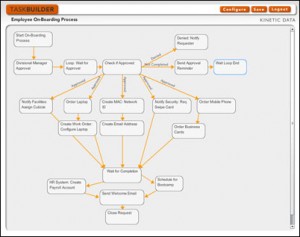What’s New at Kinetic: Building Smart in 2026
At Kinetic, we believe the future of Business Process Management isn’t bigger—it’s smarter.
New employees are the lifeblood of every organization, particularly now as enterprises grapple with the post-COVID return to offices and the Great Resignation. Beyond that above-average turnover, at...

New employees are the lifeblood of every organization, particularly now as enterprises grapple with the post-COVID return to offices and the Great Resignation. Beyond that above-average turnover, at some point in any enterprise it’s impossible to grow without adding people.
Implementing an organized employee provisioning process makes life better for both the organization and the new employee, at what is often (and even more so today) a very stressful time. Enterprises want to get new employees settled in, up to speed, and contributing productively as quickly as possible. Employees want to get started on their jobs with minimal wait time and chaos.
And yet, “at many companies, provisioning new hires is a haphazard affair, often amounting to little more than handing out a laptop and a building pass,” according to the Wall Street Journal in How (and How Not) to Train New Staff on IT. While it provisioning processes have improved since this article was first published, they still include manual, ad hoc, paper-based processes in many organizations.
According the WSJ article, “Many of the mistakes companies make come from starting too late and not having a clear ‘onboarding’ process.” While IT clearly plays a pivotal role in bringing new employees into the company (provisioning computer hardware, mobile device management, email and application access, phones, printer access and more), several other departments also need to be involved.
 Human resources (HR) needs to get the employee set up with payroll, benefits, emergency contact information, training, etc. Facilities needs up to set and provision furnishings for the employee’s workspace. Accounting needs to coordinate pay- and expense-based setup tasks with HR. And so on.
Human resources (HR) needs to get the employee set up with payroll, benefits, emergency contact information, training, etc. Facilities needs up to set and provision furnishings for the employee’s workspace. Accounting needs to coordinate pay- and expense-based setup tasks with HR. And so on.
What’s needed is for managers in each department to map out their provisioning tasks, approvals and deliverables, and coordinate these tasks with other departments. Then look for opportunities to automate as many of the tasks as possible to reduce labor, costs, and the potential for errors due to redundant manual data entry.
While onboarding processes will be different across departments and levels (e.g., the process for a call center operator will differ from a departmental VP), many of the same tasks still apply. So, a basic provisioning task workflow can be created, then modified as needed for various roles.
“One of the dumb ways of getting new employees set up is to have a complex process of approval for access to systems. New staff members can end up waiting days or weeks for managers in different departments to give them access to what they need,” according to the WSJ story.
Provisioning role-based system and application access should be part of the onboarding process flow as described above. For situations where the employee is in a new role for which systems access isn’t completely defined, or in which it’s determined after the employee starts that he or she needs access to an application that wasn’t specified in the onboarding process, incorporation of a smart service portal (sort of an “Amazon.com” for any type of internal company service and equipment requests) can enable that access gap to be quickly filled.
A properly implemented BYOD approach can both keep employees happy and reduce costs for the organization. The Journal article is spot-on that there do need to be guardrails around on the program, with both limitations and requirements clearly communicated up front, but “banning all personal devices is increasingly unrealistic.” In today’s workplace, it’s simply out of the question.
“Giving someone access to an intranet site with instructions to read it and watch a few videos isn’t as effective as one-to-one training,” as the WSJ points out, but there is an even smarter approach. Pardon the cliché, but this is an area where “thinking outside the box” can really make a difference.
Rather than just considering various methods of training, consider designing new interfaces — what Forrester Research calls “systems of engagement“ — on top of vital, but often complex, core enterprise applications (systems of record).
For example, a call center operator may need to utilize information from multiple applications and screens in order to answer even a few common questions. Rather than spend hours on training (regardless of the method used), build a consumer-grade interface with perhaps just a handful of clearly-labeled fields that provides the operator with the essential capabilities and information needed to resolve the customer issue while hiding all of the underlying complexity and cross-system navigation.
This approach can reduce to training time required, at least for many common tasks, to virtually zero. A clear and streamlined user interface that eliminates the need for training is often the best training approach of all.
The combination of mapping the entire provisioning process flow, automating as many tasks as feasible, and doing as much of this work as possible before the employee arrives for the first day on the job, will get each new employee off to a comfortable, chaos-free and productive start as rapidly as possible.

At Kinetic, we believe the future of Business Process Management isn’t bigger—it’s smarter.

IT support automation uses software workflows, rule engines, AI/ML, and integrations to automate...

Business process reimagined is the strategic renewal of how work gets done by combining modern digital...